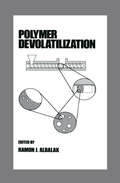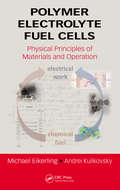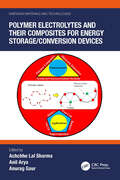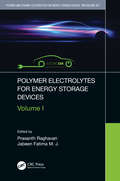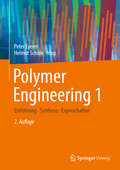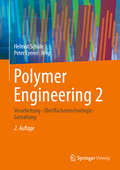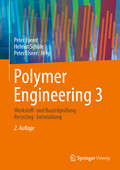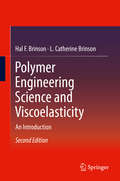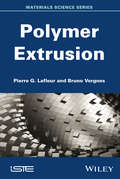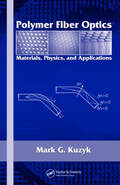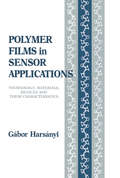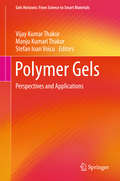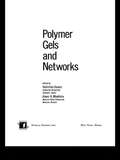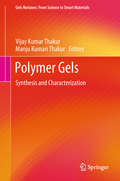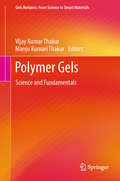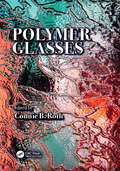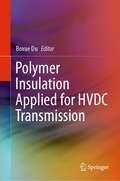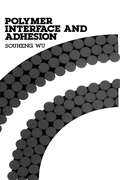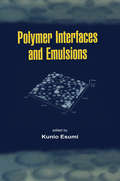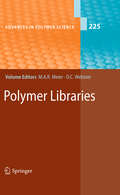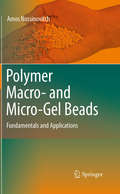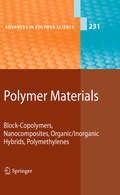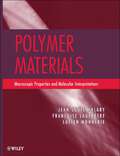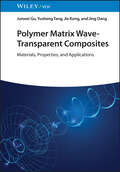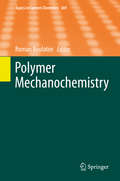- Table View
- List View
Polymer Devolatilization
by Ramon J. AlbalakThis work introduces the fundamental background necessary to understand polymer devolatilization. It elucidates the actual mechanisms by which the devolatilization of polymer melts progresses, and discusses virtually every type of devolatilization equipment available. The work also addresses devolatilization in various geometries and types of equipment, describing the use of falling strand, slit, single-screw, co-rotating and counter-rotating twin-screw devolatilization.
Polymer Electrolyte Fuel Cells: Physical Principles of Materials and Operation
by Michael Eikerling Andrei KulikovskyThe book provides a systematic and profound account of scientific challenges in fuel cell research. The introductory chapters bring readers up to date on the urgency and implications of the global energy challenge, the prospects of electrochemical energy conversion technologies, and the thermodynamic and electrochemical principles underlying the op
Polymer Electrolytes and their Composites for Energy Storage/Conversion Devices (Emerging Materials and Technologies)
by Anurag Gaur Anil Arya Achchhe Lal SharmaPolymer Electrolytes and their Composites for Energy Storage/Conversion Devices presents a state-of-the-art overview of the research and development in the use of polymers as electrolyte materials for various applications. It covers types of polymer electrolytes, ion dynamics, and the role of dielectric parameters and a review of applications. Divided into two parts, the first part of the book focuses on the types of polymer electrolytes, ion dynamics, and the role of dielectric parameters, while the second part provides a critical review of applications based on polymer electrolytes and their composites. This book: Presents the fundamentals of polymer composites for energy storage/conversion devices Explores the ion dynamics and dielectric properties role in polymer electrolytes Provides detailed preparation methods and important characterization techniques to evaluate the electrolyte potential Reviews analysis of current updates in polymer electrolytes Includes various applications in supercapacitor, battery, fuel cell, and electrochromic windows The book is aimed at researchers and graduate students in physics, materials science, chemistry, materials engineering, energy storage, engineering physics, and industry.
Polymer Electrolytes for Energy Storage Devices
by Prasanth Raghavan and Jabeen Fatima M. J.Polymer Electrolytes for Energy Storage Devices, Volume I, offers a detailed explanation of recent progress and challenges in polymer electrolyte research for energy storage devices. The influence of these electrolyte properties on the performance of different energy storage devices is discussed in detail. Features: • Discusses a variety of energy storage systems and their workings and a detailed history of LIBs • Covers a wide range of polymer-based electrolytes including PVdF, PVdF-co-HFP, PAN, blend polymeric systems, composite polymeric systems, and polymer ionic liquid gel electrolytes • Provides a comprehensive review of biopolymer electrolytes for energy storage applications • Suitable for readers with experience in batteries as well as newcomers to the field This book will be invaluable to researchers and engineers working on the development of next-generation energy storage devices, including materials, chemical, electrical, and mechanical engineers, as well as those involved in related disciplines.
Polymer Engineering 1: Einführung, Synthese, Eigenschaften
by Peter Eyerer Helmut SchüleDas Fachwissen über Technologien im Polymer Engineering ist neben dem Nachschlagewerk ''Domininghaus'' (Kunststoffe – Eigenschaften und Anwendungen) als Fach- und Lehrwerk zugleich Referenz für die industrielle Produktion und den Einsatz von Polymerwerkstoffen. Wichtige Abschnitte wie Oberflächentechnologien für Kunststoffbauteile und die Prüfung von Kunststoffen und Bauteilen wurden ergänzt um ein neues Kapitel über synthetische und natürliche Polymere und Faserverbundwerkstoffe. Den Grundlagen zum Extrudieren, dem Blasformen und Kalandrieren, den Polyurethanschäumen, der Mikrowellentechnologie, dem Rapid Prototyping und Molded Interconnected Devices, der Plasmatechnologie und den Trocknungsverfahren, konstruktives Gestalten, Fügen und Verbinden, Berechnungsansätze und Simulation, den Bauteilkosten, den Prüfungen an Thermoplasten/Duroplasten/Elastomeren und der Produktqualifikation sind weitere aktualisierte Abschnitte gewidmet. Ausgewählte Technologien werden zusammengefasst dargestellt.Band 1 des dreibändigen Werkes beinhaltet die Einführung und behandelt die Synthese von Polymeren sowie deren Eigenschaften.
Polymer Engineering 2: Verarbeitung, Oberflächentechnologie, Gestaltung
by Peter Eyerer Helmut SchülePolymere in technischen Produkten können unter ganzheitlicher Betrachtung nachhaltig und sicher eingesetzt werden.Für Werkstoffe, Komponenten und Produktsysteme gibt dieses Werk nachhaltige Antworten auf die wichtigen technischen, wirtschaftlichen, ökologischen und sozial relevanten komplexen Fragestellungen. Der Inhalt wurde gegenüber der Vorauflage sorgfältig bearbeitet und erheblich erweitert. Die Gliederung des Werks umfasst auch die Gestaltung von Kunststoffbauteilen, die Oberflächentechnologien für Kunststoffbauteile und die Prüfung von Kunststoffen und Bauteilen. In den Ausführungen gibt es umfangreiche Informationen, Übersichten und Ergänzungen zum Extrudieren, Blasformen, Kalandrieren, Polyurethanschäumen, zur Mikrowellentechnologie, zu additiven Verfahren, über Molded Interconnected Devices, Plasmatechnologie, Trocknungsverfahren, zum Gestalten, Fügen und Verbinden, Berechnungsansätze und Simulation, über Bauteilkosten, sowie Prüfungen an Thermoplasten/Duroplasten/Elastomeren und zur Produktqualifikation. Ausgewählte Technologien werden zusammengefasst dargestellt.Band 2 des dreibändigen Werkes behandelt die Verarbeitung von Polymeren, Oberflächentechnologien sowie die Entwicklung und Gestaltung von Bauteilen.
Polymer Engineering 3: Werkstoff- und Bauteilprüfung, Recycling, Entwicklung
by Peter Eyerer Peter Elsner Helmut SchülePolymere in technischen Produkten können unter ganzheitlicher Betrachtung nachhaltig und sicher eingesetzt werden.Für Werkstoff, Komponenten und Produktsysteme gibt dieses Werk nachhaltige Antworten auf die wichtigen technischen, wirtschaftlichen, ökologischen und sozial relevanten komplexen Fragestellungen. Der Inhalt wurde gegenüber der Vorauflage sorgfältig bearbeitet und erheblich erweitert. Die Gliederung des Werks umfasst auch die Gestaltung von Kunststoffbauteilen, die Oberflächentechnologien für Kunststoffbauteile und die Prüfung von Kunststoffen und Bauteilen. In den Ausführungen gibt es umfangreiche Informationen, Übersichten und Ergänzungen zum Extrudieren, Blasformen, Kalandrieren, Polyurethanschäumen, zur Mikrowellentechnologie, zu additiven Verfahren, über Molded Interconnected Devices, Plasmatechnologie, Trocknungsverfahren, zum Gestalten, Fügen und Verbinden, Berechnungsansätze und Simulation, über Bauteilkosten, sowie Prüfungen an Thermoplasten/Duroplasten/Elastomeren und zur Produktqualifikation. Ausgewählte Technologien werden zusammengefasst dargestellt.Band 3 des dreibändigen Werkes beinhaltet die Werkstoff- und Bauteilprüfung, Betrachtungen zum Recycling und zur Nachhaltigkeit sowie einen Ausblick auf laufende Entwicklungen.
Polymer Engineering Science and Viscoelasticity
by Hal F. Brinson L. Catherine BrinsonThis book provides a unified mechanics and materials perspective on polymers: both the mathematics of viscoelasticity theory as well as the physical mechanisms behind polymer deformation processes. Introductory material on fundamental mechanics is included to provide a continuous baseline for readers from all disciplines. Introductory material on the chemical and molecular basis of polymers is also included, which is essential to the understanding of the thermomechanical response. This self-contained text covers the viscoelastic characterization of polymers including constitutive modeling, experimental methods, thermal response, and stress and failure analysis. Example problems are provided within the text as well as at the end of each chapter. New to this edition: · One new chapter on the use of nano-material inclusions for structural polymer applications and applications such as fiber-reinforced polymers and adhesively bonded structures · Brings up-to-date polymer production and sales data and equipment and procedures for evaluating polymer characterization and classification · The work serves as a comprehensive reference for advanced seniors seeking graduate level courses, first and second year graduate students, and practicing engineers
Polymer Extrusion
by Bruno Vergnes Pierre G. LafleurExtrusion is by far the most important and the oldest processing and shaping method for thermoplastic polymers. This process concerns almost all synthetic polymers, as well as elastomers or food materials. Single-screw extrusion is mainly used nowadays to manufacture finished goods or semi-finished products. More than 90 million tons of thermoplastics are therefore processed every year. Twin-screw extrusion may be divided into two systems: contra-rotating systems used within the context of PVC extrusion, for the manufacture of pipes or profiles; and co-rotating systems experiencing nowadays a very significant development, because of their significant adaptability and flexibility, which enables the manufacture of specific materials (polymer alloys, thermoplastic elastomers, filled polymers, nanocomposites). Extrusion is carried out by passing molten polymer through a tool called die that will give the product its final shape (films and sheets, rolled products, and electric cables). Thanks to the design of dies, we obtain at the output a product with controlled dimensions, uniform speeds and homogeneous temperatures. The book will discuss the same production types, but only in the case of coextrusion flows, i.e. multilayer stratified products. First of all, we will present in this book the physics of the mechanisms at stake, then propose more or less complex models in order to describe these mechanisms and then go forward in the interpretation of results and the control of condition flows.
Polymer Fiber Optics: Materials, Physics, and Applications (Optical Science and Engineering)
by Mark G. KuzykThis straightforward text examines the scientific principles, characterization techniques, and fabrication methods used to design and produce high quality optical fibers. Polymer Fiber Optics: Materials, Physics, and Applications focuses on the fundamental concepts that will continue to play a role in future research and applications. This book documents the underlying physics of polymer fibers, particularly aspects of light interaction, and details the practical considerations for a broad range of characterization techniques used to investigate new phenomena. The book presents basic fabrication techniques and protocols that will likely remain useful as new advances address specific processing challenges. The author presents a fresh approach to standard derivations, using numerous figures and diagrams to break down complex concepts and illustrate theoretical calculations. The final chapters draw attention to the latest directions in research and novel applications, including photomechanical actuation, electro-optic fibers, and smart materials.
Polymer Films in Sensor Applications
by Gabor HarsanyiPolymer films now play an essential and growing role in sensors. Recent advances in polymer science and film preparation have made polymer films useful, practical and economical in a wide range of sensor designs and applications. Further, the continuing miniaturization of microelectronics favors the use of polymer thin films in sensors. This new book is the first comprehensive presentation of this technology. It covers both scientific fundamentals and practical engineering aspects. Included is an extensive survey of all types of sensors and applications. The very detailed table of contents in the next pages provides full information on content. More than 200 schematics illustrate a wide variety of sensor structures and their function.
Polymer Gels
by Vijay Kumar Thakur Manju Kumari Thakur Stefan Ioan VoicuThis book summarizes the recent advances in the science and engineering of polymer-gel-based materials in different fields. It also discusses the extensive research developments for the next generation of smart materials. It takes an in-depth look at the current perspectives and market opportunities while pointing to new possibilities and applications. The book addresses important topics such as stimuli responsive polymeric nanoparticles for cancer therapy; polymer gel containing metallic materials; chemotherapeutic applications in oncology; conducting polymer-based gels and their applications in biological sensors; imprinted polymeric gels for pharmaceutical and biomedical purposes; applications of biopolymeric gels in the agricultural sector; application of polymer gels and their nanocomposites in electrochemistry; smart polyelectrolyte gels as a platform for biomedical applications; agro-based polymer gels and their application in purification of industrial water wastes; polymer gel composites for bio-applications. It will be of interest to researchers working in both industry and academia.
Polymer Gels and Networks
by Yoshihito Osada Alexei KhokhlovProvides comprehensive coverage of the most recent developments in the theory of non-Archimedean pseudo-differential equations and its application to stochastics and mathematical physics--offering current methods of construction for stochastic processes in the field of p-adic numbers and related structures. Develops a new theory for parabolic equations over non-Archimedean fields in relation to Markov processes.
Polymer Gels: Perspectives And Applications (Gels Horizons: From Science To Smart Materials Ser.)
by Vijay Kumar Thakur Manju Kumari ThakurThis book addresses a range of synthesis and characterization techniques that are critical for tailoring and broadening the various aspects of polymer gels, as well as the numerous advantages that polymer gel-based materials offer. It presents a comprehensive collection of chapters on the recent advances and developments in the science and fundamentals of both synthetic and natural polymer-based gels. Topics covered include: synthesis and structure of physically/chemically cross-linked polymer-gels/polymeric nanogels; gel formation through non-covalent cross-linking; molecular design and characterization; polysaccharide-based polymer gels: synthesis, characterization, and properties; modified polysaccharide gels: silica-based polymeric gels as platforms for the delivery of pharmaceuticals; gel-based approaches in genomic and proteomic sciences; emulgels in drug delivery; and organogels. The book provides a cutting-edge resource for researchers and scientists working in various fields involving polymers, biomaterials, bio-nanotechnology and functional materials.
Polymer Gels: Science and Fundamentals (Gels Horizons: From Science to Smart Materials)
by Vijay Kumar Thakur Manju Kumari ThakurThis book exclusively focuses on the science and fundamentals of polymer gels, as well as the numerous advantages that polymer gel-based materials offer. It presents a comprehensive collection of chapters on the recent advances and developments in the core science and fundamentals of both synthetic and natural polymer-based gels, and pays particular attention to applications in the various research fields of biomedicine and engineering. Key topics addressed include: polysaccharide-based gels and their fundamentals; stimuli-responsive polymer gels; polymer gels applied to enzyme and cell immobilization; chitosan-based gels for cancer therapy; natural polymeric and gelling agents; radiation dosimetry; polymeric gels as vehicles for enhanced drug delivery across the skin; transport in and through gel; and polymer gel nanocomposites and functional gels. The book’s extensive and highly topical coverage will appeal to researchers working in a broad range of fields in industry and academia alike.
Polymer Glasses
by Connie B. Roth"the present book will be of great value for both newcomers to the field and mature active researchers by serving as a coherent and timely introduction to some of the modern approaches, ideas, results, emerging understanding, and many open questions in this fascinating field of polymer glasses, supercooled liquids, and thin films" –Kenneth S. Schweizer, Morris Professor of Materials Science & Engineering, University of Illinois at Urbana-Champaign (from the Foreword) This book provides a timely and comprehensive overview of molecular level insights into polymer glasses in confined geometries and under deformation. Polymer glasses have become ubiquitous to our daily life, from the polycarbonate eyeglass lenses on the end of our nose to large acrylic glass panes holding water in aquarium tanks, with advantages over glass in that they are lightweight and easy to manufacture, while remaining transparent and rigid. The contents include an introduction to the field, as well as state of the art investigations. Chapters delve into studies of commonalities across different types of glass formers (polymers, small molecules, colloids, and granular materials), which have enabled microscopic and molecular level frameworks to be developed. The authors show how glass formers are modeled across different systems, thereby leading to treatments for polymer glasses with first-principle based approaches and molecular level detail. Readers across disciplines will benefit from this topical overview summarizing the key areas of polymer glasses, alongside an introduction to the main principles and approaches.
Polymer Insulation Applied for HVDC Transmission
by Boxue DuThis book focuses on polymer insulation as applied to HVDC transmission. It addresses both fundamental principles and engineering practice, with more weight placed on the latter. This is achieved by providing in-depth studies on a number of major topics such as DC insulation structure, DC insulation design, nanocomposites, modification, testing and performance evaluation. In turn, several typical HVDC insulation application cases are examined in detail, e.g. cables, cable accessories, GIS/GIL, and converter transformers. A comprehensive and systematic study on polymer insulation modification and ageing assessment is one of the book’s major features, making it particularly well suited for readers who are interested in learning about polymer insulation materials. Given its scope, it offers a valuable resource for researchers, engineers and graduate students in the fields of high-voltage and insulation technologies, electrical engineering, material engineering, etc.
Polymer Interface and Adhesion
by WuPoly mer Interface and Adhesion provides the critical basis for further advancement in thisfield. Combining the principles of interfacial science, rheology, stress analysis, and fracturemechanics, the book teaches a new approach to the analysis of long standing problemssuch as: how is the interface formed; what are its physical and mechanical properties;and how does the interface modify the stress field and fracture strength of the material.The book offers many outstanding features, including extensive listings of pertinent references,exhaustive tabulations of the interfacial properties of polymers, critical reviews ofthe many conflicting theories, and complete discussions of coupling agents, adhesion promotion,and surface modifications. Emphasis is placed on physical concepts and mechanisms,using clear, understandable mathematics.Polymer Interface and Adhesion promotes a more thorough understanding of the physical,mechanical, and adhesive properties of multiphase, polymer systems. Polymer scientistsand engineers, surface chemists, materials scientists, rheologists, as well as chemical andmechanical engineers interested in the research, development or industrial applications ofpolymers, plastics, fibers, coatings, adhesives, and composites need this important newsource book.
Polymer Interfaces and Emulsions
by Kunio Esumi"Presents the latest knowledge on a wide range of topics in polymer science, including the dynamics, preparation, application, and physiochemical properties of polymer solutions and colloids; the adsorption characteristics at polymer surfaces; and the adhesion properties (including acid-base) of polymer surfaces."
Polymer Libraries
by Dean C. Webster Michael A. MeierMeier/Webster: General Aspects of Polymer Libraries. - Schubert: Polyoxazoline Libraries and/or the General. - Fasolka: Gradient Methods for Polymer Libraries, Including their Microfluidic Polymerization Methods. - Becker: Bioactive Libraries. - Adams: The Computer-Aided Design of Polymers.
Polymer Macro- and Micro-Gel Beads: Fundamentals and Applications
by Amos NussinovitchThe use of hydrocolloid (water-soluble polymer) beads is on the rise in many fields. A book that covers both past and new applications for hydrocolloid beads, their properties, and how to deliberately change them, is crucial. Currently there are only chapters in a handful of books covering these topics; there are no books fully devoted to them. Water-Soluble Polymer Beads: Fundamentals and Applications fills this void. This book describes all methods of bead production and techniques to change and to estimate their physical and chemical properties. A full description of past and recent developments and applications of beads in the fields of agriculture, biotechnology, environmental studies, medicine and food are presented.
Polymer Materials
by Kwang-Sup Lee Shiro Kobayashi-On the Mechanisms Leading to Exfoliated Nanocomposites Prepared by Mixing By C. D. Han -Phase Behavior and Phase Transitions in AB- and ABA-type Microphase-Separated Block Copolymers By J. K. Kim, C. D. Han -New Class Materials of Organic-Inorganic Hybridized Nanocrystals/Nanoparticles, and Their Assembled Microand Nano-Structure Toward Photonics By H. Oikawa, T. Onodera, A. Masuhara, H. Kasai, H. Nakanishi -Poly(substituted Methylene) Synthesis: Construction of C-C Main Chain from One Carbon Unit By E. Ihara
Polymer Materials: Macroscopic Properties and Molecular Interpretations
by Francoise Laupretre Lucien Monnerie Jean Louis HalaryAdvanced reviews for Polymer Materials "Molecular modeling of polymers ... is a subject that cannot be found in any other [book] in any appreciable detail. ... [T]he detailed chapters on specific polymer systems is a great idea." — Gregory Odegard, Michigan Technological University "The polymer community needs a text book which can connect the macroscopic mechanics with mesoscopic and molecular aspects of polymer." — Liangbin Li, University of Science and Technology of China This book takes a unique, multi-scale approach to the mechanical properties of polymers, covering both the macroscopic and molecular levels unlike any other book on the market. Based on the authors’ extensive research and writing in the field, Polymer Materials emphasizes the relationships between the chemical structure and the mechanical behavior of polymer materials, providing authoritative guidelines for assessing polymer performance under different conditions and the design of new materials. Key features of this book include: Experimental results on selected examples precede and reinforce the development of theoretical features In-depth discussions of a limited number of polymer systems instead of a brief overview of many Self-contained chapters with a summary of their key points Comprehensive problems and a solutions manual for the different parts of the book Coverage of the basics with an emphasis on polymer dynamics An indispensable resource for polymer scientists and students alike, Polymer Materials is also highly useful for material scientists, engineers, chemists, and physicists in industry and academia.
Polymer Matrix Wave-Transparent Composites: Materials, Properties, and Applications
by Junwei Gu Yusheng Tang Jie Kong Jing DangPolymer Matrix Wave-Transparent Composites One-stop reference on important recent research accomplishments in the field of polymer matrix wave-transparent composites Polymer Matrix Wave-Transparent Composites: Materials, Properties, and Applications is a unique book that focuses on polymer matrix wave-transparent composites for electromagnetic wave transmission of a certain frequency, discussing various aspects of design, fabrication, structure, properties, measurement methods, and mechanisms, along with practical applications of functional polymer composites in industrial fields ranging from aircraft radomes, to radomes for ground, shipborne, and airborne purposes, to radomes for 5G communication, to printed circuit boards and beyond. Edited by four highly qualified academics and contributed to by well-known experts in the field, Polymer Matrix Wave-Transparent Composites includes detailed discussion on sample topics such as: Interface between the reinforced fiber and polymer matrix, including basic concepts, characterization, and the most common method of functionalization for the interfaceMechanism of wave-transparent, factors that influence wave-transparent performance, and fabrication techniques Processes of hand paste molding, pressure bag molding, laminated molding, resin transfer molding (RTM), and winding molding Physical and chemical properties of the inorganic fibers (glass fibers and quartz fibers) and organic fibers (aramid fibers, ultra-high molecular weight polyethylene fibers and poly-p-phenylene benzobisoxazole fibers) Polymer Matrix Wave-Transparent Composites is an essential reference on the latest research in the field for researchers and related professionals, as well as for individuals who are not familiar with the field and wish to gain a holistic understanding in one place.
Polymer Mechanochemistry
by Roman BoulatovThe series Topics in Current Chemistry presents critical reviews of the present and future trends in modern chemical research. The scope of coverage is all areas of chemical science including the interfaces with related disciplines such as biology, medicine and materials science. The goal of each thematic volume is to give the non-specialist reader, whether in academia or industry, a comprehensive insight into an area where new research is emerging which is of interest to a larger scientific audience. Each review within the volume critically surveys one aspect of that topic and places it within the context of the volume as a whole. The most significant developments of the last 5 to 10 years are presented using selected examples to illustrate the principles discussed. The coverage is not intended to be an exhaustive summary of the field or include large quantities of data, but should rather be conceptual, concentrating on the methodological thinking that will allow the non-specialist reader to understand the information presented. Contributions also offer an outlook on potential future developments in the field. Review articles for the individual volumes are invited by the volume editors. Readership: research chemists at universities or in industry, graduate students.
